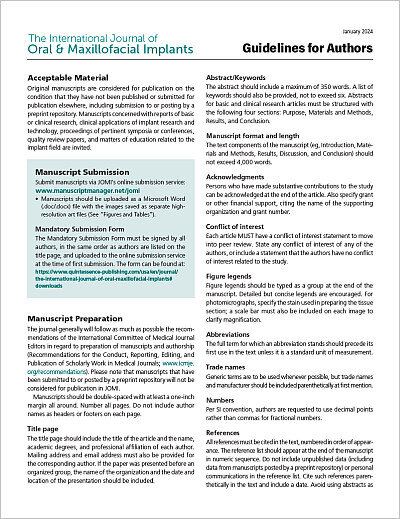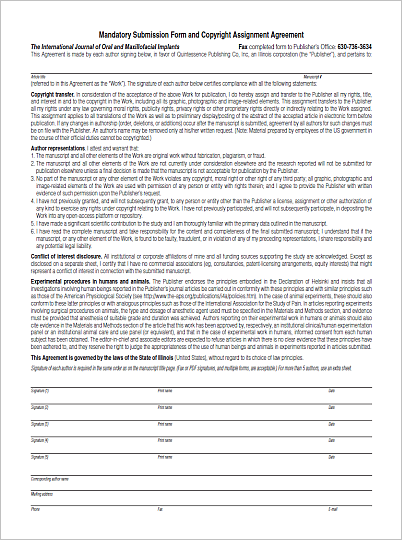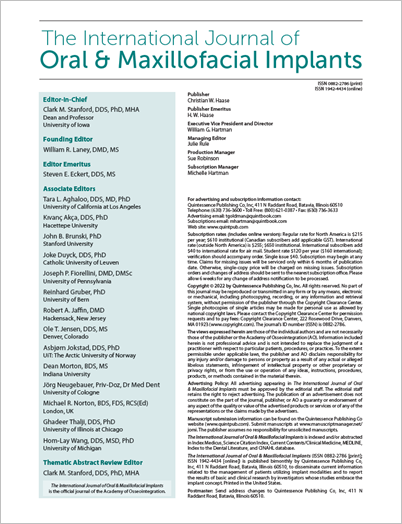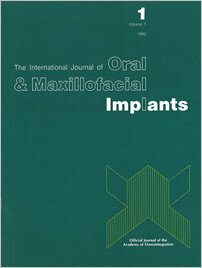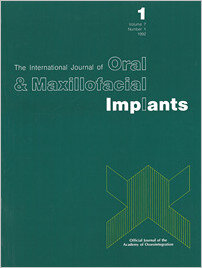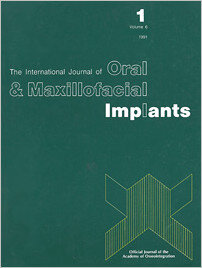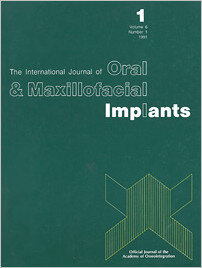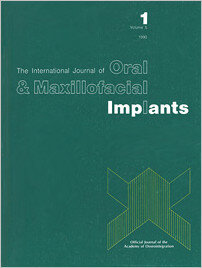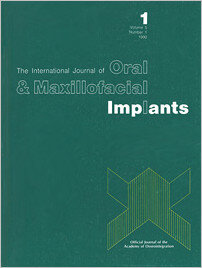Pages 295-296, Language: EnglishBrunski, John B.Pages 297-301, Language: EnglishRutherford, R. Bruce / Sampath, T. Kuber / Rueger, David C. / Taylor, Thomas D.An enriched bovine osteogenic protein preparation in combination with bone collagen matrix (osteogenic protein device) was used to effect new bone growth in extraction sites in the presence or absence of titanium dental implants. Incisor and canine teeth were extracted from each of three cynomolgus monkeys, and implants were inserted directly into the sockets without surgical site preparation. The osteogenic protein device induced new bone formation in close apposition to the titanium implants in all trials within 3 weeks. A lesser amount of new bone formation in both sets of control sites was limited to the bony socket walls and not closely apposed to the implant. These data show that the osteogenic protein device is capable of inducing new bone formation in tooth sockets within 3 weeks in the presence or absence of titanium implants. This is the first known demonstration of the therapeutic induction of bone formation in close apposition to metallic implants.
Keywords: bone morphogenetic protein, bone regeneration, endosseous titanium implant, osteogenic protein, osteogenesis
Pages 302-310, Language: EnglishBowers, Kurt T. / Keller, John C. / Randolph, Brad A. / Wick, Donald G. / Michaels, Christine M.In vitro cellular responses of osteoblast-like cells were studied on titanium surfaces with different surface morphologies. Surface profilometry was used to determine whether rough or smooth surfaces with regular or irregular morphologies can be produced by conventional fabrication techniques. Significantly higher levels of cellular attachment were found using rough, sandblasted surfaces with irregular morphologies. These results correlate with recent in vivo findings and suggest that implants should be prepared with roughened surfaces at bony contact areas.
Keywords: average surface roughness, cell attachment, osteoblast responses, surface morphology
Pages 311-320, Language: EnglishDesjardins, Ronald P.The position of osseointegrated implants in the edentulous maxilla is dictated by available bone and can vary widely among patients. Anatomy limits the amount of bone available for placement of osseointegrated implants. With increasing resorption, the number, length, and position of implants are further compromised. Bone grafts are frequently needed to place implants of adequate length. The variability of implant placement indicates the need for multiple prosthesis designs in the maxilla. Prosthesis design considerations are suggested for patients with minimal, moderate, and severe resorption of the edentulous maxilla.
Keywords: edentulous maxilla, prosthesis design
Pages 321-329, Language: EnglishArvidson, Kristina / Bystedt, Hans / Frykholm, Anders / von Konow, Lars / Lothigius, EricA prospective study for the treatment of mandibular edentulism using the new Astra dental implant system was conducted on 54 patients. The clinical performance of 310 implants was monitored over 3 years. The survival rate was 100% for the prostheses and 98. 1% for individual implants. Four implants failed during the first 3 months after placement, one was retained as a sleeper, and two more were removed because of persistent discomfort. Both resorption and deposition of mandibular marginal bone were observed. Bone changes from baseline to the end of the first year ranged from -0.4 to + 1.0 mm (median 0.00), from the first to the third year from -0.8 to +0.6 mm (median 0.04), and over the 3 years ranged from - 1.1 to + 1.0 mm (median 0.01). No marked mean bone resorption was observed during the first year compared to the two following years. A significant gain in marginal bone level was recorded in males, but in females the level was unchanged. There were no serious inflammatory reactions in the surrounding soft tissues during the 3-year follow-up period.
Keywords: clinical study, implantology, longitudinal study, mandible, osseointegration, screw implants, surgical procedures, titanium implants
Pages 330-337, Language: EnglishBauman, Geoffrey R. / Mills, Michael / Rapley, John W. / Hallmon, William W.This article is a review of plaque-induced inflammation around dental implants. The microflora around successful implants is similar to healthy sulci, while that associated with failing implants is similar to periodontally diseased sites. Implant microflora is similar to the tooth microflora in the partially edentulous mouth. The microflora of implants in partially edentulous mouths differs from that in edentulous mouths. This seems to indicate a bacterial reservoir around the teeth and the possibility of reinfection of the implant sulcus by periodontal pathogens. The maintenance of a tooth microflora consistent with periodontal health in partially edentulous mouths may lead to maintaining an implant microflora consistent with peri-implant health. Thus, periodontal and implant maintenance are linked and neither can be overlooked.
Keywords: implant maintenance, inflammation, microflora, peri-implant health, plaque
Pages 338-344, Language: EnglishVargas, Eduardo / Baier, Robert E. / Meyer, Anne E.Inductively coupled argon plasma spectroscopic analysis was used to quantify titanium aluminum, and vanadium corrosion products released by superficial layers of identically shaped commercially pure titanium and Ti-6Al-4V alloy dental implants. Halves of each of two originally sterile groups were analyzed directly from the manufacturer's packaging and the other halves received glow-discharge treatment prior to their corrosion assay. The implants were incubated in pH 3 modified saline solution and were analyzed after 2- and 12-week corrosion periods. Implants treated with glow discharge showed statistically significant reduction in the amounts of corrosion products released, apparently as a result of glow-discharge-produced surface oxides of greater passivity than originally present.
Keywords: aluminum, dental implants, glow-discharge treatment, ICAP spectroscopy, surface analysis, titanium, vanadium
Pages 345-352, Language: EnglishHobkirk, J. A. / Psarros, K. J.Masticatory forces associated with porcelain and acrylic resin occlusal surfaces on osseointegrated implant-supported prostheses opposing natural teeth were studied in five healthy subjects. A three-channel electronic force transducer carrying a fixed prosthesis with either acrylic resin or porcelain occlusal surfaces and balanced articulation was used to record masticatory forces while the subjects chewed various foods. It was found that mean peak masticatory forces varied considerably from subject to subject but were consistent within each subject. No differences related to tooth material could be detected in the load rates. Forces directed away from the implants were noted in all subjects.
Keywords: acrylic resin, dental implants, force, occlusion, porcelain
PubMed ID (PMID): 1289261Pages 353-359, Language: EnglishJörnéus, Lars / Eng, Mech / Jemt, Torsten / carlsson, Lennart / Eng, ElectThe problem of screw stability was approached in this study by calculating the maximum occlusal forces in vito for patients with single implant restorations (which use only one screw to secure the prosthetic reconstruction to the implant). The measurements of occlusal forces together with geometric parameters for the individual patients wre used to determine the necessary holding capabilities of the screw joint. Different screw designs were tried in bench test situations and the results were compared with clinical situations. A gold alloy screw with a flat head and high tightening torque (35 Ncm) produced the best result.
Keywords: occlusal force, screw design, screw stability, single tooth implants
Pages 360-366, Language: EnglishMisch, Craig M. / Misch, Carl E. / Resnik, Randy R. / Ismail, Yahia H.Partially edentulous patients with alveolar defects contraindicating implant placement were treated with bone grafts obtained from the mandibular symphysis. Complications encountered were minor and uneventful. Evaluation 4 months after surgery revealed minimal graft resorption, thus implant placement was possible in all potential sites. Advantages of the symphysis graft include easy access, availability of greater quantities of bone over other intraoral donor sites, low morbidity, no hospitalization, minimal discomfort, no alteration in ambulation, and no cutaneous scar. Compared with other bone regenerative methods for implant placement, a superior quality of bone was found and a shorter healing period is required. Results of this preliminary clinical investigation demonstrate that chin grafts offer a viable alternative for reconstruction of alveolar defects prior to dental implant placement.
Keywords: alveolar defect, autogenous graft, dental implants, mandibular symphysis
Pages 367-372, Language: EnglishSmith, Richard A. / Berger, Richard / Dodson, Thomas B.A total of 104 consecutive patients treated with 313 Nobelpharma implants was studied to determine the medical risks associated with dental implants. There did not appear to be an increased implant failure rate or an increase in perioperative morbidity in patients with a compromised medical status. Age; sex; and concurrent use of hypoglycemic agents, supplemental female hormones, or steroids also did not correlate with increased implant failure or perioperative morbidity. Implant procedures using a variety of pain-/anxiety-control agents failed to reveal any increase in anesthetic-related complications. However, the number of implants placed per patient did correlate with implant failure. It appears that implant surgery and the required anesthetic appear to be safe procedures even in the medically compromised patient.
Keywords: complications, dental implants, medical risks
Pages 373-380, Language: EnglishWilliams, Marie Y. A. / Mealey, Brian L. / Hallmon, William W.Dental implant therapy has dramatically expanded the treatment options available for both the partially and completely edentulous patient. Advances in the use of dental implants have necessitated the inclusion of additional diagnostic procedures in the treatment planning process to optimize the site and angulation of fixtures and, consequently, the success of prosthetic restorations. One of these procedures is computerized tomography. Originally introduced as a medical diagnostic technique, it has been adapted for many uses in dentistry. This article reviews the role of computerized tomography in dental implantology. Its advantages, disadvantages, and indications are presented.
Keywords: computerized tomography, diagnosis, implants
Pages 381-388, Language: EnglishJacobson, Jed J. / Maxson, Barbara B. / Mays, Keith / Kowalski, Charles J.By applying a utility (usefulness) scale termed the Feeling Thermometer to 111 edentulous patients, a measure of effectiveness (quality-adjusted prosthesis years) that can be compared across several treatment strategies was developed. The results suggest that the utility scale was a valid (known group, P .05), reliable (intraclass correlation coefficient = .713) measure of patients' preferences for the three treatment strategies: (1) conventional complete dentures (controls, n = 77), (2) transosteal implant-supported prostheses (n = 19), and (3) endosseous implant-supported prostheses (n = 15). The implant-treated patients rated their prostheses as high or higher (Feeling Thermometer score of 86.3 [endosseous] and 82.3 [transosteal]) than a functional fitting, esthetic conventional denture (score of 85.0 [endosseous] and 82.0 [transosteal]). They were also younger, more educated, and had received more sets of dentures (P .05) than conventional denture patients.
Keywords: dental implant, edentulism, patient preferences, treatment decisions, utility analysis
Pages 390-394, Language: EnglishPröbster, Lothar / Lin, Weili / Hüttemann, HorstThis study demonstrates that titanium, which is well known for its corrosion resistance, does not withstand certain acidic fluoride prophylactic agents. Neutral sodium fluoride solutions do not affect titanium surfaces. If fluoride preparations are to be used in patients who have titanium implants or restorations, the effect of the agent on titanium must be examined to prevent damage to the restorations.
Keywords: fluoride, prophylactic agents, surface corrosion, titanium
Pages 395-400, Language: EnglishSmith, Keith G. / Franklin, Christopher D. / van Noort, Ric / Lamb, David J.The early histologic response to implantation of two newly developed machinable calcium phosphate ceramics was investigated. One of the materials is a machinable form of hydroxyapatite and the other a new machinable glass ceramic. One month following implantation, new bone had grown onto the surface of both implants. Further bone deposition and remodeling occurred during the ensuing 2 months. In the future, machinable qualities of these materials may make them extremely useful as implant materials.
Keywords: glass ceramic, hydroxyapatite, implant material, machinable
Pages 401-404, Language: EnglishShonberg, David C. / Stith, Herbert D. / Jameson, Lee M. / Chai, John Y.A patient with a severely resorbed mandible was treated with five Brånemark fixtures. Following stage 1 surgery, the patient experienced an apparently spontaneous fracture involving the left terminal implant. The implant was left in place and the fracture was treated with mandibular splinting and intermaxillary fixation. The fracture healed and the implant became osseointegrated.
Keywords: endosseous implant, mandibular fracture




